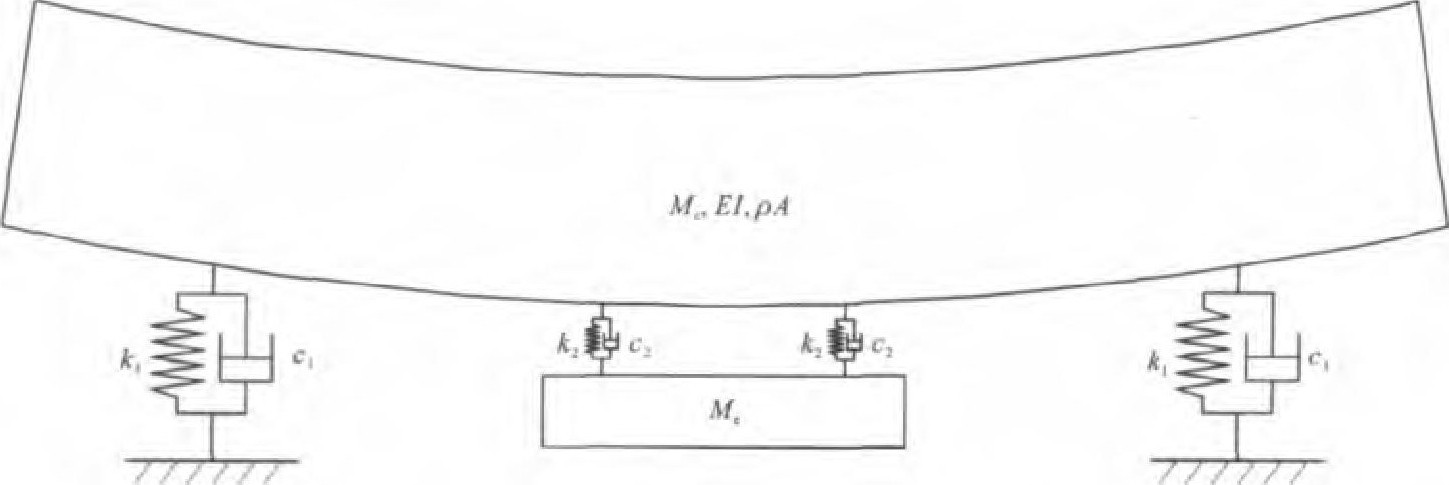-
摘要: 为了考虑车体的弹性振动, 将车体等效成欧拉伯努利梁, 建立了车体与设备垂向耦合振动模型, 研究了车下设备刚性悬挂与弹性悬挂对车体振动幅频特性的影响。基于模态叠加法原理建立了考虑车体弹性振动和车下设备的高速动车组三维刚柔耦合动力学模型, 分析了车下设备悬挂方式、重心偏载与弹性悬挂参数对车体振动响应的影响规律。采用欧拉伯努利梁模型的数值分析结果表明:基于动力吸振器原理, 当车下设备采用合理的弹性悬挂参数时能够有效抑制车体的弹性振动, 并提高车体的垂向弯曲频率。采用三维刚柔耦合动力学模型仿真结果表明:车辆运行速度越高弹性悬挂的优点越明显, 车下设备横向偏载主要影响车体的横向振动特性, 纵向偏载主要影响车体的垂向振动特性;当车下设备的悬挂频率接近车体的垂向弯曲频率时能够降低车体的整体振动水平, 当车下设备的悬挂频率低于车体的垂向弯曲频率时, 提高车下设备弹性悬挂系统的阻尼能够在一定程度上抑制车体的弹性振动。Abstract: In order to consider the elastic vibration of carbody, the vertical coupling vibration model of carbody and equipment was established, the influence of rigid suspension and flexible suspension on the amplitude-frequency characteristic of carbody was studied, in which carbody was modeled as an Euler-Bernoulli beam. The 3D rigid-flexible coupling dynamics model of high-speed EMU was set up based on the modal superposition method and considering carbody elastic vibration and equipment, the influence of equipment's suspension types, partial loads and suspension parameters on carbody vibration was andyzed. The numerical analysis result of Euler-Bernoulli beam model shows that reasonable elastic suspension design based on the principle of dynamic vibration absorber can effectively suppress the elastic vibration of carbody and improve the vertical bend frequency of carbody. The simulation result of 3D rigid-flexible coupling dynamics model shows that the higher the speed is, the more obvious the advantage of elastic suspension is, equipment's lateral partial load affects the lateral riding index of carbody, and the longitudinal partial load mainly affects the vertical riding index. When the flexible suspension frequency of equipment is close to carbody bend frequency, the minimum vibration of carbody occurs. But as the suspension frequency of equipment is less than carbody bend frequency, rising damping can suppress carbody vibration to some extent.
-
表 1 车下设备和车体参数
Table 1. Parameters of equipment and carbody

表 2 设备弹性悬挂参数
Table 2. Elastic suspension parameters of equipment

-
[1] SUZUKI Y, AKUTSU K. Theoretical analysis of flexural vibration of car body[J]. QR of RTRI, 1990, 31 (1): 42-48. [2] DIANA G, CHELI F, BRUNI S, et al. Dynamic interaction between rail vehicle and track for high speed train[J]. Vehicle System Dynamics, 1995, 24 (1): 15-30. [3] YOUNG T H, LI C Y. Vertical vibration analysis of vehicle/imperfect track systems[J]. Vehicle System Dynamics, 2003, 40 (5): 329-349. doi: 10.1076/vesd.40.5.329.17912 [4] ZHOU J, GOODALL R, REN L, et al. Influence of carbody vertical flexibility on ride quality of passenger railway vehicles[J]. Journal of Rail and Rapid Transit, 2009, 223 (5): 461-471. doi: 10.1243/09544097JRRT272 [5] 周劲松, 张伟, 孙文静, 等. 铁道车辆弹性车体动力吸振器减振分析[J]. 中国铁道科学, 2009, 30 (3): 86-90. https://www.cnki.com.cn/Article/CJFDTOTAL-ZGTK200903017.htmZHOU Jin-song, ZHANG Wei, SUN Wen-jing, et al. vibra-tion reduction analysis of the dynamic vibration absorber on the flexible carbody of railway vehicles[J]. China Railway Science, 2009, 30 (3): 86-90. (in Chinese). https://www.cnki.com.cn/Article/CJFDTOTAL-ZGTK200903017.htm [6] 曾京, 罗仁. 考虑车体弹性效应的铁道客车系统振动分析[J]. 铁道学报, 2007, 29 (6): 19-25. https://www.cnki.com.cn/Article/CJFDTOTAL-TDXB200706005.htmZENG Jing, LUO Ren. Vibration analysis of railway passen-ger car systems by considering flexible carbody effect[J]. Journal of the China Railway Society, 2007, 29 (6): 19-25. (in Chinese). https://www.cnki.com.cn/Article/CJFDTOTAL-TDXB200706005.htm [7] 黄彩虹, 曾京, 邬平波, 等. 铁道客车车体弹性振动减振研究[J]. 工程力学, 2010, 27 (12): 250-256. https://www.cnki.com.cn/Article/CJFDTOTAL-GCLX201012041.htmHUANG Cai-hong, ZENG Jing, WU Ping-bo, et al. Study on carbody flexible vibration reduction for railway passenger carriage[J]. Engineering Mechanics, 2010, 27 (12): 250-256. (in Chinese). https://www.cnki.com.cn/Article/CJFDTOTAL-GCLX201012041.htm [8] 曾京, 邬平波, 郝建华. 铁道客车系统的垂向减振分析[J]. 中国铁道科学, 2006, 27 (3): 62-67. https://www.cnki.com.cn/Article/CJFDTOTAL-ZGTK200603010.htmZENG Jing, WU Ping-bo, HAO Jian-hua. Analysis of verti-cal reduction for railway vehicle systems[J]. China Railway Science, 2006, 27 (3): 62-67. (in Chinese). https://www.cnki.com.cn/Article/CJFDTOTAL-ZGTK200603010.htm [9] CARLBOM P F. Combining MBS with FEM for rail vehicle dynamics analysis[J]. Multibody System Dynamics, 2001, 6 (3): 291-300. doi: 10.1023/A:1012072405882 [10] ENELUND M, MÄHLER L, RUNESSON K, et al. Formu-lation and integration of the standard linear viscoelastic solid with fractional order rate laws[J]. International Journal of Solids and Structures, 1999, 36 (16): 2417-2442. [11] BERG M. A model for rubber springs in the dynamic analysis of rail vehicles[J]. Journal of Rail and Rapid Transit, 1997, 211 (2): 95-108. [12] BERG M. A non-linear rubber spring model for rail vehicle dynamics analysis[J]. Vehicle System Dynamics, 1998, 30 (3): 197-212. [13] BRUNI S, VINOLAS J, BERG M, et al. Modelling of sus-pension components in a rail vehicle dynamics context[J]. Vehicle System Dynamics, 2011, 49 (7): 1021-1072. [14] BRUNI S, COLLINA A. Modelling the viscoelastic behav-iour of elastomeric components: an application to the simula-tion of train-track interaction[J]. Vehicle System Dynamics, 2000, 34 (4): 283-301. -





 下载:
下载:


















